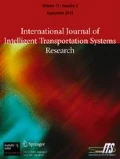Abstract
Understanding conditions and situations causing abnormal driving behaviors like sudden braking or sudden acceleration is important for preventing traffic accidents. Previous studies have used probe vehicle data to detect risky situations where sudden braking frequently occurred. However, they have mainly focused on location and vehicle-related factors. In this paper, we build models which discriminate sudden braking using a machine learning method. The models use weather-related information as well as probe data. To investigate how weather-related factors help to determine sudden braking, we conducted extensive experiments using probe data obtained from dashboard cameras and two types of weather-related information obtained from meteorological observatories (MO) and AMeDAS. Experimental results illustrate that using weather-related information improves performance in determining sudden braking and that the temporally and spatially denser characteristics of weather-related factors from AMeDAS help to compensate for insufficiencies in the model with MO data.









Similar content being viewed by others
References
Kawatani, T., Itoh, E., Hirokawa, S., Mine, T.: Machine learning and visualization of sudden braking using probe data, AAI2019, pp. 67–72 (2019)
Kawatani, T., Itoh, E., Hirokawa, S., Mine, T.: Location does not always determine sudden braking, Intelligent Transportation Systems Conference, pp. 875—882 (2019)
Traveling data of official vehicles and public transportation vehicles, the Aizu-Wakamatsu Open Data Project, https://data.data4citizen.jp/dataset/10060158. Accessed 23 May 2020
Prokhorenkova, L., Gusev, G., Vorobev, A., Dorogush, A.V., & Gulin, A.: CatBoost: unbiased boosting with categorical features. Adv. Neural Inf. Proces. Syst. 6638–6648 (2018)
Makino, H., Tamada, K., Sakai, K., Kamijo, S.: Solutions for urban traffic issues by ITS technologies. Int. Assoc. Traffic Saf. Sci. 42, 49–60 (2018)
Ozaki, Y., Yata, J., Kamiya, S., Yabu, M., Takamiya, S.: Study on a method to identify hazardous spots by using probe data(in Japanese). Civ. Eng. J. 56, 28–31 (2014)
Michitsuji, Y., Nagai, M.: Analysis on factor of drivers’ sudden stopping decisions during yellow phase using drive recorder. Int. Assoc. Traffic Saf. Sci. 33(4), 57–64 (2008)
Júnior, J.F., Carvalho, E., Ferreria, B.V., Souza, C., Suhara, Y., Prentland, A., Pessin, G.: Drive behavior profiling: an investigation with different smartphone and machine learning. PLoS One. 12(4), e0174959 (2017)
Peng, J., Shao, Y.: Intelligent Method for Identifying Driving Risk Based on V2V Multisource Big Data, Complexity (2018)
Ozbayoglu, M., Kucukayan, G., Dogdu, E.: A real-time autonomous highway accident detection model based on big data processing and computational intelligence, 2016 IEEE International Conference on Big Data, pp. 1807–1813 (2016)
Parsa, A.B., Taghipour, H., Derrible, S., Mohammadian, A.K.: Real-time accident detection: coping with imbalanced data. Accid. Anal. Prev. 129, 202–210 (2019)
Parsa, A.B., Movahedi, A., Taghipour, H., Derrible, S., Mohammadian, A.K.: Toward safer highways, application of XGBoost and SHAP for real-time accident detection and feature analysis. Accid. Anal. Prev. 136, 105405 (2020)
Friedman, J.H.: Greedy Function Approximation: a Gradient Boosting Machine,” Ann. Stat. JSTOR. 1189–1232 (2001)
Acknowledgments
This work is partly supported by JSPS KAKENHI Grant Numbers JP19KK0257 and JP20H01728.
Author information
Authors and Affiliations
Corresponding author
Additional information
Publisher’s Note
Springer Nature remains neutral with regard to jurisdictional claims in published maps and institutional affiliations.
Rights and permissions
About this article
Cite this article
Sato, Y., Kawatani, T. & Mine, T. Influence of Weather Features in Determining Sudden Braking. Int. J. ITS Res. 19, 366–377 (2021). https://doi.org/10.1007/s13177-021-00253-6
Received:
Revised:
Accepted:
Published:
Issue Date:
DOI: https://doi.org/10.1007/s13177-021-00253-6




